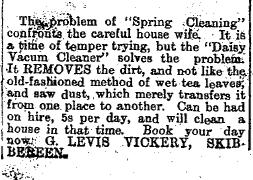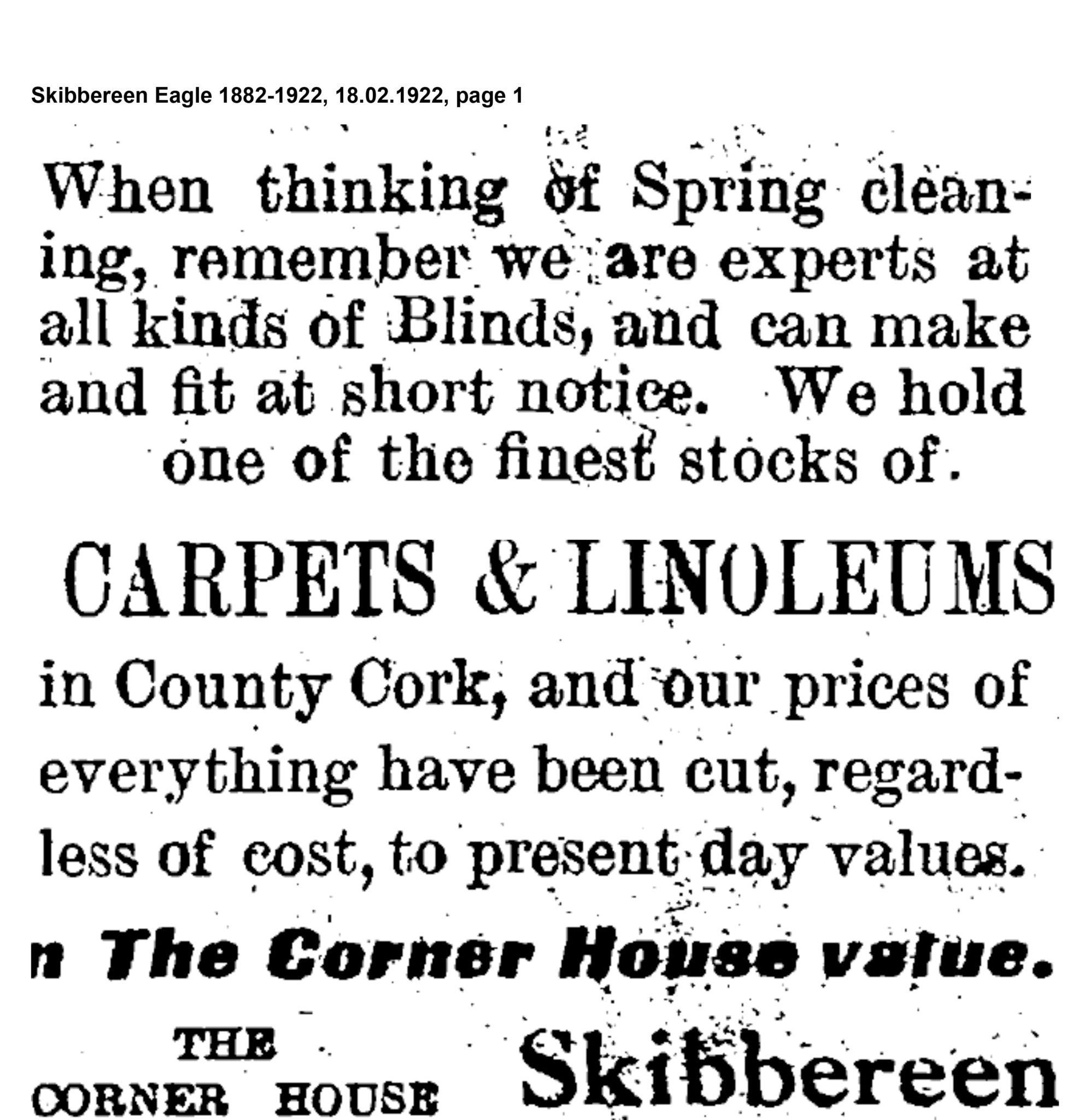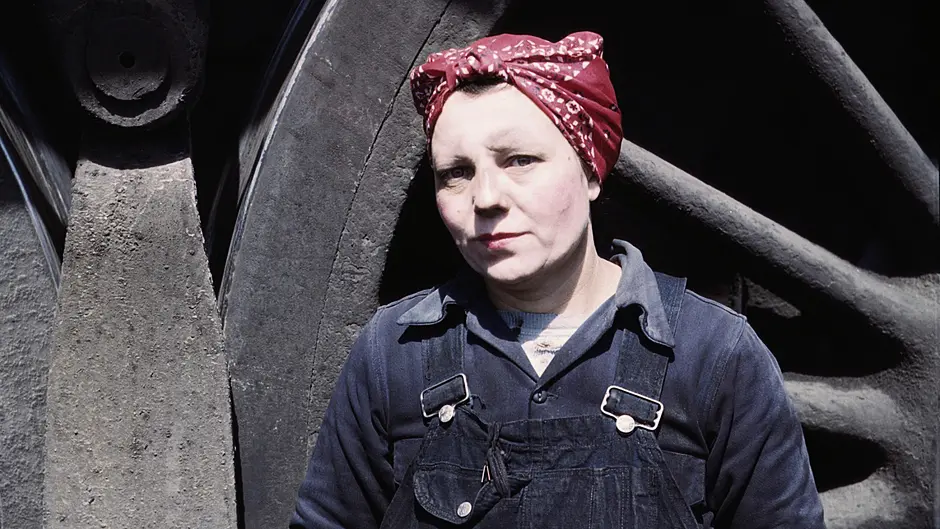
Today’s labour-saving devices have made the ‘spring clean’ relatively painless. But not that long ago, newspapers described it as a ‘formidable undertaking’
WHETHER we do it simply because our grannies always did, or because the season’s stronger light wakes us from our winter slumber – and shows up all our dust – spring cleaning is something few of us look forward to.
In Kenneth Grahame’s book The Wind in the Willows (1908), Mole tries tackling the work with brooms, dusters and whitewash, but ends up with an aching back and arms. ‘Hang spring cleaning!’ he yells, as he flings his brush down.
 One of the earliest vacuum cleaners, the ‘Baby Daisy’ from 1911, now in Queensland Museum
One of the earliest vacuum cleaners, the ‘Baby Daisy’ from 1911, now in Queensland Museum
The press sympathised with his predicament. The Southern Star described spring cleaning in 1909 in terms of a military ‘campaign’ that involved ‘80% elbow grease’ and huge upheaval. In 1911 The Skibbereen Eagle called it ‘temper-trying’, especially when every dust-trapping nook and cranny, carving and hanging, needed cleaning. The Cork Examiner went further in 1938, dubbing it a ‘horrible bogey’, consisting of ‘one, two or even three weeks of scrubbing and scouring … Only moving home could cause more disruption than the annual spring clean’.
Housewives were offered plenty of tips: Go about the work ‘systematically’, urged the Skibbereen Eagle in 1893. ‘Forethought is the mother of success. For goodness sake do not be haphazard’, agreed The Southern Star in 1909. Gather together everything you need in advance – brushes, dusters, buckets of water. Start at the top of the house ‘with all your forces of attack around you’, and work downwards. Finish one room before starting another: that is the golden rule.
 an ad for the 'Baby Daisy' in the Skibbereen Eagle in 1911.
an ad for the 'Baby Daisy' in the Skibbereen Eagle in 1911.
First, tackle chimneys – if you neglected them for Santa’s visit – otherwise soot will leak onto every freshly-cleaned surface, warned The Southern Star in 1895.
Next, whitewash your smoke-stained ceilings. Cover large pieces of furniture with sheets, but take smaller items outside to be aired, scrubbed and polished, noting that leather furniture should be ‘cleaned with eggwhite’. Cupboards must be emptied, and objects not put back ‘until every spot of dust is removed’, and shelves relined with fresh paper. Protect against ‘creepy-crawlies’ and moths by applying insect powder – manufactured by Lester’s of Cork.
Thoroughly wipe all paintwork with a flannel, using a little warm water and ammonia, and rub papered walls with stale bread. Take up carpets, beat and brush them, and hang them to air. Remove and wash lino before rubbing it over with milk, and limewash the floorboards. Don’t forget sheds and outhouses!
West Cork’s shops swept spring cleaners off their feet with goods and services: Phelan’s in Bandon boasted a ‘huge assortment of wallpaper’ and liners, paste powder, paints and varnish, brushes, dustpans and manual carpet sweepers. In Kinsale, Maurice Murphy offered to trim paper, while in Bantry, Vickery & Co invited customers to leaf through their pattern books.
But if you first needed to unclog a sooty chimney, better head to Cain O’Mahony & Sons, Skibbereen, which carried ‘a large stock’ of canes and brushes – both fibre and wire.
 Local advertisement for tips on spring cleaning in The Southern Star, in 1954
Local advertisement for tips on spring cleaning in The Southern Star, in 1954
The arrival of the ‘Baby Daisy’ vacuum cleaner on the eve of the First World War had promised to rescue West Cork housewives from hours of drudgery and backache. Unlike the mucky old-fashioned method of attempting to remove carpet dirt using wet tealeaves and sawdust – which simply transferred mess from one place to another – and traditional beating – which ‘drove dust into the housewife’s face and hair’ – the ‘Baby’ could apparently suck up ‘every atom’ of dust from carpets, upholstery, furniture and books ‘easily and effectively’. Available for hire at 5 shillings per day from G Levis Vickery of Skibbereen, it could apparently clean your place in that time because you didn’t need to remove carpets, or ‘exert yourself in the least’.
 Local advertisement for tips on spring cleaning in the Skibbereen Eagle in 1922.
Local advertisement for tips on spring cleaning in the Skibbereen Eagle in 1922.
The only problem was it took two people to operate: one to pedal the bellows like crazy, the other to wield the hose! Electric vacuum cleaners weren’t common until the late 1960s.
Once your place was clean and papered, Powers of Skibbereen could help with lace curtains, blankets and quilts, and the Corner House with carpets, lino, and blinds, made and fitted ‘at short notice’. Any housewife ‘worthy of the name’ should keep up to date with all the latest furnishings and colour schemes, maintained The Cork Examiner.
By doing this, commented the The Skibbereen Eagle on April 1st 1893, she could transform the family home into ‘a glorified abode, sweet-smelling, fresh, dainty and bright’.







